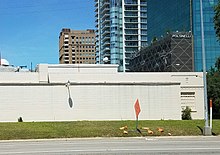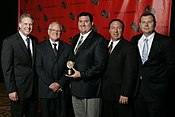WFAA
WFAA (channel 8) is a television station licensed to Dallas, Texas, United States, serving as the ABC affiliate for the Dallas–Fort Worth metroplex.This also makes Dallas the largest media market with a "Big Four" station (ABC, NBC, CBS, Fox) that is not owned by that respective network.Hoblitzelle planned to operate the station out of the Republic Bank building in downtown Dallas, and even conducted a closed-circuit television broadcast of the opening of one of his properties, the Wilshire Theatre.Texas oil magnate Tom Potter filed a separate application for the Channel 8 license and was ultimately awarded the permit over Hoblitzelle.The station originally operated from studio facilities located at Harry Hines Boulevard and Wolf Street, north of downtown Dallas.Lacy-Potter Television Broadcasting lost $128,020 in net revenue during its four-month stewardship of KBTV, leading Tom Potter to make the decision to put the station up for sale.Originally debuting in March 1961 as Mr. Peppermint, Haynes (who donned a red- and white-striped jacket and straw hat in his portrayal of the titular character, accompanied by a candy-striped cane) starred alongside a variety of puppet characters (performed by Vern Dailey) and presented various segments from educational content to cartoon shorts; five years after ending its original nine-year run on WFAA in 1970, the program was revived as the half-hour magazine-style educational series Peppermint Place in 1975, running for 21 additional years—expanding into syndication for its final seven—until the program ended its collective 30-year run in July 1996.[6] Other notable WFAA local productions included the music series The Group And Chapman and its progenitor Sump'n Else (both of which were hosted by Ralph Baker Jr. and Ron Chapman), Dallas Bandstand (also hosted by Haynes), lifestyle and fashion talk program The Julie Bennell Show (hosted by Dallas Morning News food editor Julie Bennell), the viewer Q&A series Let Me Speak to the Manager (originally titled Ask the Manager and later named Inside Television for the final four years of its run, co-hosted by Belo vice president Myron "Mike" Shapiro), and local versions of the Dialing for Dollars and PM Magazine franchises.The first live telecast to originate from the building was Young America Speaks, a 13-week intercollegiate debate tournament series (the first such program ever televised), which aired until June of that year.Among its purchases in later years, Belo acquired the Corinthian Broadcasting subsidiary of Dun & Bradstreet in December 1983, adding six additional stations—including CBS affiliate KHOU in Houston—to its portfolio (forcing the respective sales of KFDM and WTVC to Freedom Communications, and of WISH-TV in Indianapolis and WANE-TV in Fort Wayne, Indiana, to LIN Broadcasting, to comply with FCC ownership limits); and added ten additional stations through its 1997 merger acquisition of the Providence Journal Company.[12] The 5,000-square-foot (465 m2) facility, which opened in January 2007, incorporates a street-level studio where most of the station's news programming (with the exception of the 10 p.m. newscast) and the local talk show Good Morning Texas is produced, and houses news production staff and engineering operations; initially, the building also housed certain operations run by Belo's other Dallas-based properties, including its publishing division.The WFAA Communications Center continues to house the station's newsroom and most other business operations (including its master control, traffic, advertising and programming departments).The sale was completed on November 20 with KMPX moving most of its internal operations days later into WFAA's Communications Center Studios on Young Street.Most Mavericks games will air on KFAA-TV, which became an independent station and concurrently changed its call letters from KMPX; the Estrella TV programming moved to its second digital subchannel.WFAA had control over 820 during prime evening hours, when the 50,000-watt clear channel signal could often be heard as far west as California and as far east as New York (at the time, there were significantly fewer radio stations that were operating at night, reducing the likelihood of interference).Initially acting as a simulcast of the AM station, WFAA-FM programmed a MOR and beautiful music format until 1973, when it changed to album oriented rock (AOR) under the call letters KZEW-FM (branded as "The Zoo") on September 16, 1973.Belo sold both KRQX and KZEW-FM on January 1, 1987; the FM station has since changed its calls to KBFB and maintains an urban contemporary format.In rare instances, this channel space is used to air preempted ABC programming due to live sporting events such as Monday Night Football when the Dallas Cowboys are scheduled to play.[40] WFAA produces the talk, entertainment and lifestyle program Good Morning Texas, which airs weekdays at 9 a.m. and is produced independently of WFAA's news department; the hour-long program, which debuted on September 12, 1994, under original hosts Scott Sams and Deborah Duncan (as of June 2016[update], it is currently co-hosted by Erin Hunter and former KXAS-TV anchor Jane McGarry), served as the basis for other similarly formatted local late-morning talk shows that debuted on its sister stations under Belo ownership in subsequent years.Both series moved to KTVT, with the former being replaced by Entertainment Tonight, which prior to the change, Channel 8 had aired following Nightline since it acquired the rights to ET from KDFW in September 1984.The station usually aired the block continuously via the network's "live" feed from 7 a.m. to noon until September 1998, when WFAA separated the lineup (by then, known under the Disney's One Saturday Morning banner) into two blocks bookending the newly launched Saturday edition of News 8 Daybreak, with the first two hours being switched to a one-week delayed broadcast from 5 to 7 a.m. and the final three hours continuing to air off the "live" network feed from 9 a.m. to noon.In the past, WFAA has also chosen to preempt certain ABC programs because of content deemed inappropriate by station management, in some cases due to concerns over possible FCC-imposed fines.[46] It was also among the more than 20 ABC-affiliated stations that declined to air the network's telecast of Saving Private Ryan in November 2004, due to concerns over possible fines over the intense war violence and strong profanity in the film that ABC opted against editing out of the broadcast amid the FCC's crackdown on indecent material following the wardrobe malfunction incident that occurred during Justin Timberlake and Janet Jackson's Super Bowl XXXVIII halftime show performance that February.WFAA was the first U.S. television station to make use of international satellite capacity, broadcasting a live program (anchored by the late Murphy Martin) from Paris, France, in 1969, consisting of interviews with wives of American POWs in Vietnam.It was perhaps the first in the nation to broadcast videotaped field reports (film was used almost exclusively in local news until the late 1970s and early 1980s), televising the arrival of President Richard Nixon at Dallas Love Field within 30 minutes of his plane's touchdown in 1969 (a Sony reel-to-reel video recorder made for home use was pressed into service for this broadcast presented on a regular, midnight newscast).WFAA uncovered significant stories in the 1980s including information of academic improprieties that would lead to the Southern Methodist University football team being given the "death penalty" in the mid-1980s, as well as the first major media investigation into the America's Savings & Loan scandal that was rooted in Texas.; the current iteration was initially conducted by John Criswell during his stint as co-host of the retooled AM, before becoming a weekly feature on WFAA's 10 p.m. newscast in September 1980.[53] WFAA was honored with Peabody Awards in 1986 (for an investigative report that led to the Southern Methodist University Mustangs' "death penalty" sanction by the NCAA),[54] 1995 (for The Peavy Investigation, a "revealing series of reports into insurance purchases involving the Dallas Independent School District... centered on the chairman of the Board of Education's Committee on Insurance"),[55] 2002 (for the investigative report series Fake Drugs, Real Lives, about confidential informants who worked with Dallas police that planted powdered Sheetrock or billiard chalk near unsuspecting Mexican immigrants to "contrive drug cases"),[56] 2004 (for State of Denial, a long-running series into improprieties in the Texas Workers Compensation Commission, part of the Texas Department of Insurance),[57] 2007 (for four separate investigative stories: "Money for Nothing", about a major U.S. financial institution that made loans to non-existent companies in Mexico; "The Buried and the Dead", on the safety issues of pipelines carrying gas into homes; "Television Justice", about regional law-enforcement officers who collaborated with news crews to produce a prime time television program; and "Kinder Prison", on the deplorable conditions at a juvenile detention facility)[58] and 2010 (for "Bitter Lessons", an investigation into government-funded career schools).A statement from the station claimed that computer automation which preset the commercial breaks and triggered them as if the coverage did not take place caused that night's episode of Jimmy Kimmel Live!The reasoning behind its proposal for the power increase was due to difficulties experienced by some viewers in portions of the Dallas–Fort Worth market who tried to maintain adequate over-the-air reception of the channel 8 digital signal.



DallasFort Worth, TexasChannelsDigitalVirtualTegna Inc.Sister stationsKFAA-TVFormer affiliationsDuMontParamountCall signFacility IDTranslator(s)Decaturtelevision stationDallas–Fort Worth metroplexindependent stationhigh definitiondowntown DallasThe Dallas Morning NewsCedar Hill, Texasowned and operatedABC Owned Television StationsBig FourFort WorthFederal Communications Commissionconstruction permitlicenseSouthern United Statesclosed-circuit televisionKERA-TVpublic radiovariety seriesAlben W. BarkleyKXAS-TVKPRC-TVHoustonDuMont Television NetworkParamount Television NetworkParamount PicturesA.H. Belo CorporationArdmore, OklahomaAbileneKTXS-TVflagship stationGannett CompanyMississippi Rivercall signscities of licenseArbitronmedia marketsFort Worth Star-TelegramAmon G. CarterCedar Hillcandelabra towereffective radiated powerJerry HaynespuppetcartoonSump'n ElseRalph Baker Jr.Ron ChapmanDialing for DollarsPM MagazineTexas Country ReporterBob Phillipsvideotapereality seriesConfessionNational Educational TelevisionState Sen.KFDM-TVChattanooga, TennesseeDun & BradstreetFreedom CommunicationsWISH-TVIndianapolisWANE-TVFort Wayne, IndianaLIN BroadcastingProvidence Journal CompanyAustinSan AntonioJames R. Kirkmusic packageMcKinneyStephen Arnold Music615 MusicNorfolkWWL-TVNew OrleansSacramentoCorpus ChristiKWES-TVOdessaGari Media GroupF-4 PhantomDallas Naval Air Stationguy-wiresKRLD-FMKKDA-FMRed RiverShermanGainesvilleOklahomaDurantKOCO-TVOklahoma CityNorth Texasdigital subchannelCable OneDenisonJanuary 1Texas Cable Newsstatewide cable news channelpublic affairslayoffsVictory ParkAmerican Airlines Centermaster controlsplit offAl DíaNeighborsgoA. H. Belo CorporationDallas Times-Herald